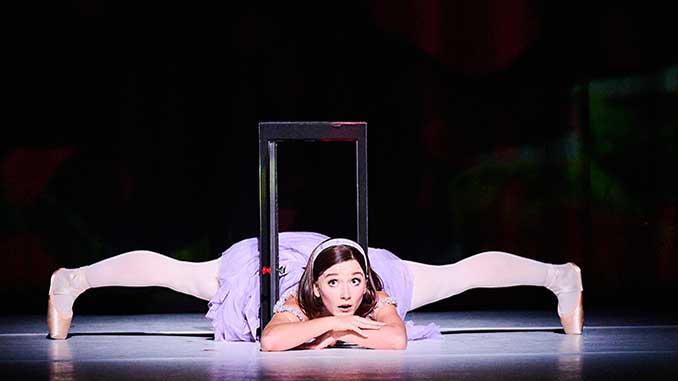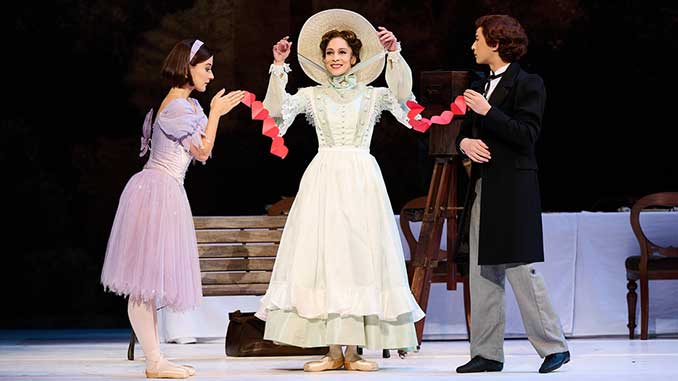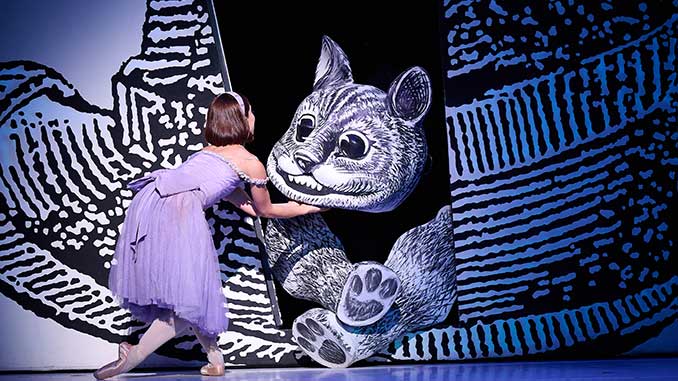 Lewis Carroll’s enduring 1865 children’s novel, Alice’s Adventures in Wonderland, inspires an imaginatively concocted work and an utterly pleasurable experience of theatrical escapism in The Australian Ballet’s (AB) latest revival of English choreographer Christopher Wheeldon’s lavish production for the Royal Ballet which premiered in 2011.
Lewis Carroll’s enduring 1865 children’s novel, Alice’s Adventures in Wonderland, inspires an imaginatively concocted work and an utterly pleasurable experience of theatrical escapism in The Australian Ballet’s (AB) latest revival of English choreographer Christopher Wheeldon’s lavish production for the Royal Ballet which premiered in 2011.
Allusions to real-life characters in Carroll’s story are manipulated and emphasised in Wheeldon’s work, beginning with a refined and buzzing picnic in an Oxford private garden where an adolescent Alice (Benedicte Bemet) and her two sisters are entertained by Lewis Carroll (Brett Chynoweth).
The appearance of the young gardener, Jack (Joseph Calley), who gives Alice a rose and who later becomes the Knave, signals thoughts of romantic developments to come. Alice returns his gift with a tart, her peevish, social-climbing mother and later Queen of Hearts (Robyn Hendricks) accuses Jack of stealing it and he is shockingly dismissed.
 Shortly after, Carroll brings his camera, ducks under the cover to take a photograph and begins a transformation into the White Rabbit, first fabulously freezing the scene with the click of the shutter, then climbs into his bag. Alice follows and there begins her reactive, purposeful escape down the legendary hole.
Shortly after, Carroll brings his camera, ducks under the cover to take a photograph and begins a transformation into the White Rabbit, first fabulously freezing the scene with the click of the shutter, then climbs into his bag. Alice follows and there begins her reactive, purposeful escape down the legendary hole.
Turning Carroll’s literary treasure of nonsensical encounters and eccentric wordplay into a cohesive narrative for dance is no easy feat. Wheeldon’s primary card is a romance-defining work but it sadly remains insipid throughout – perhaps better succeeding if restrained by a purely platonic friendship.
What Wheeldon does best is highlight the eccentricity of the piece with choreography that ignites electricity in its characters and, although spare in use, dazzlement in its formations. Otherwise, a fun, pantomime-esque hand moves the story along, often camouflaging the embedded technical and artistic challenges, testament to the AB dancers’ exceptional world class talents. At the first interval, I overheard, “I wish there was more ballet”, under all the spectacle and in all the clamour, there is indeed alot!
Wheeldon is aided by an eye-watering visual smorgasbord courtesy of Bob Crowley’s creatively outstanding set and costume designs and Natasha Katz’s vividly detailed lighting. A naive, childlike quality enters into Jon Driscoll and Gemma Carrington’s many projections while capturing Alice’s seemingly perpetual shrinking and enlarging with awesomely clever ways in combination with the sets.
Over three acts, including two intervals, the intoxication lingers a little too long but never is the spectacle compromised. From the first soaring perspective surrounding the Victorian picnic to the wonderful hall of giant playing cards and its impeccably danced deck by the AB corps de ballet in their four-suited costumes, the wow factor is turned up.
There’s the dark, blood-spattered pork sausage-making enterprise revealed from behind the quaintly appearing needlework image of “Home Sweet Home” – its roll-about pig chair a priceless prop.
 The Duchess is a magnetic wiry and cooky sort given great frenetic energy by Ben Davis and her Cheshire Cat is a brilliant nine-piece work of puppetry art by Toby Olié.
The Duchess is a magnetic wiry and cooky sort given great frenetic energy by Ben Davis and her Cheshire Cat is a brilliant nine-piece work of puppetry art by Toby Olié.
Carroll’s Caterpillar who sits on a mushroom smoking a hookah is a bare-chested Indian Raj (Nathan Brook) who slinks with extraordinary ease and flexibility surrounded by exotic parasols.
George-Murray Nightingale tap dances the Mad Hatter’s music with sensational athleticism and showmanship, getting his own Vaudevillian stage at the tea party.
Act 2’s dance of the flowers is a sumptuous floral masterpiece, elegantly performed by the AB corps de ballet through which Bemet’s Alice and Calley’s Knave find each other again in a touching encounter, and the Queen of Hearts’ rose garden is a lively topiary affair with conical bushes that can’t keep still.
Though not always in the spotlight, Alice is almost always on stage and Bemet infuses her with requisite curiosity and an endearing joie de vivre, her gorgeously shaped arabesques, polished en pointe footwork catching attention. Calley’s boyish Knave is adorned with palpable sensitivity and enthusiasm.
 Chynoweth makes the transformation from a warm and kindly Carroll to the nervously vacillating White Rabbit with aplomb and Hendricks’ axe-loving Queen of Hearts reveals more than finger pointing directions and off-with-the-head gestures when she steps out of her bulbous heart-shaped gown casing to impress hugely with the hilarity of her evil-acting and melodramatic final turn.
Chynoweth makes the transformation from a warm and kindly Carroll to the nervously vacillating White Rabbit with aplomb and Hendricks’ axe-loving Queen of Hearts reveals more than finger pointing directions and off-with-the-head gestures when she steps out of her bulbous heart-shaped gown casing to impress hugely with the hilarity of her evil-acting and melodramatic final turn.
And the music! Joby Talbot’s ravishing and playful, history-spanning filmic score, peppered with truckloads of delightful offerings such as musical onomatopoeic boldness, rich orchestration with an abundance of characterful percussion and the carnivalesque, is instrumental in the production’s success. Orchestra Victoria are a deserved hit with conductor Jonathan Lo in confident command.
Including a giant axe that comes down at the conclusion of Act 2 with its heart-shaped droplet of blood at its tip, there are hearts in all sorts of places, not least in the work of the entire company under David Hallberg’s direction.
The romantic wash over Wheeldon’s Alice’s Adventures in Wonderland might not fly high – and the closing contemporary scene back in the Oxford garden in which a young woman put’s down a copy of the novel’s first printed version is desperate to keep that theme alive – but there’s much to celebrate in its journey for young and old alike.
Alice’s Adventures in Wonderland©
State Theatre – Arts Centre Melbourne, 100 St Kilda Road, Melbourne
Performance: Friday 15 March 2024
Season continues to 26 March 2024
Bookings: www.artscentremelbourne.com.au
For more information, visit: www.australianballet.com.au for details.
Images: Benedicte Bemet – photo by Christopher Rodgers-Wilson | Benedicte Bemet, Robyn Hendricks and Chengwu Guo – photo by Christopher Rodgers-Wilson | Benedicte Bemet and Artists of The Australian Ballet – photo by Christopher Rodgers-Wilson | Robyn Hendricks, Steven Heathcote and Artists of The Australian Ballet – photo by Christopher Rodgers-Wilson
Review: Paul Selar
